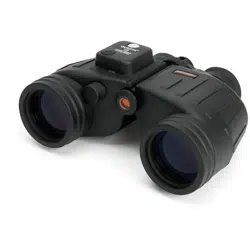Loading ...

2
USING THE RETICLE AS A MEASURING DEVICE
View Angle
View Angle of an object is the angle between the rays from the binocular to its edges. Usually, this angle is
measured at the horizontal or vertical direction, and defined as Horizontal View Angle and Vertical View Angle.
A mil’s reticle (shown to the right) that has a horizontal and vertical scale can measure the viewing angle of an
object. The Celestron binocular uses 10 mils for each number (1,2,3,… as shown here).
The Calculator Dial can be used to determine distance quickly and
easily without calculation. The Calculator Dial is located inside one of
the lens caps as shown. The Calculator Dial includes a triangular Angle
Index Mark marked “ANGLE”, a rotational Active Ring and a Fixed
Scale marked “DISTANCE”. There are two scales in the Active Ring,
one is for View Angle and the other is Size marked “OBJECT SIZE”.
First, measure the View Angle value of an object, and rotate the
Active Ring and place this value at the Angle Index Mark. Then, find
the division indicating the size of the object (see formula below),
it indicates a point at the Fixed Scale. Look at the Fixed Scale, the
distance is shown at that point on the Fixed Scale.
USING THE CALCULATOR DIAL AS A MEASURING DEVICE
ω
L
H
Measuring the Horizontal View Angle
When the Horizontal View Angle is smaller than the horizontal scale range (-40~+40 mils) inside the binocular,
aim one edge of the object at a horizontal scale line (the center or the outmost line is selected according to the
image size of the object usually) and read its value. Then read the value of the scale at which another edge was
located. Add these two values and this is the measured Horizontal View Angle. The Horizontal View Angle of
the target (sailboat) is 5 decade mils (50 mils).
When the Horizontal View Angle is larger than the horizontal scale range (-40~+40 mils), use vertical line splits
(for example: mast, sail, etc.) on the object can be selected to make the necessary estimated measurements in a
step by step fashion.
Measuring the Vertical View Angle
Vertical View Angle measurement is similar to measuring the Horizontal View Angle. When the Vertical View Angle
measurement is small, aim the intersecting point of the vertical and horizontal lines of the reticle at the lower part
of the object and read the scale value at the top of the object. The angle included between the upper and lower
parts of the target (lighthouse) is 6 decade mils (60 mils).
When the Vertical View Angle is larger than the vertical scale range (70 mils), it can be measured in steps,
and the angle can be obtained by summing up the value of each step.
Using the Reticle to Measure Distance
The distance measurement of a target can be calculated by using the mil reticle.
The formula of distance measurement: L(km) = H (m)/ω
L — the distance between the observer and the object (km)
H — the height of the object (m)
ω — the View Angle of the object measured with the reticle
of the binocular (mil).
When measuring the distance, estimate the width or height of the object and next
measure the View Angle of the object. Accordingly, you can calculate the distance
between the observer and the object using the formula.
For example:
There is an adult whose height is 1.70 m. (H = 1.70 m)
The Vertical View Angle of the adult is 4 decade mils (40 mils)
L = H/ω = 1.7/40 = 0.0425 km = 42.5 m
Therefore: the distance between the observer and the adult is 42.5 m.
(for feet conversion, multiply 42.5 by 3.28).
t
Loading ...
Loading ...
Loading ...
